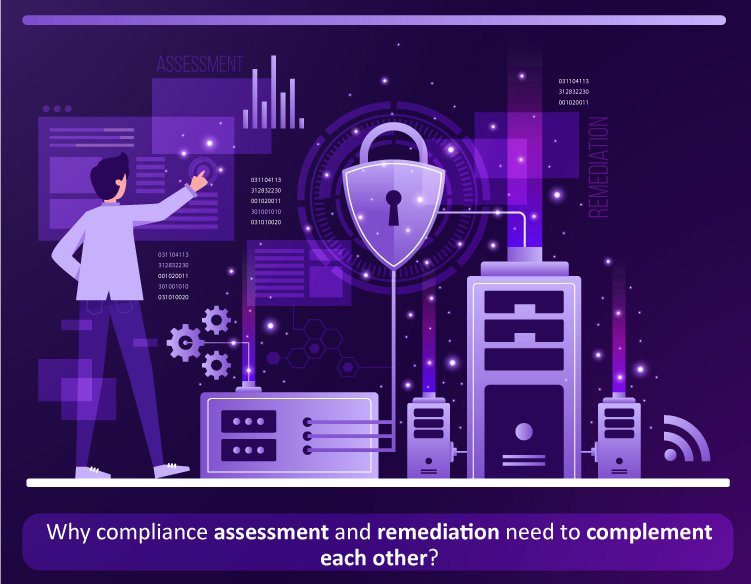Compliance assessment has become critical for many industries, with the proliferation of global regulations and targeted cyberattacks leading to data leaks costing companies millions of dollars. Industries like baking, finance, and healthcare that deal with personally identifiable information (PII) need to strictly adhere to compliance rules to ensure the safekeeping of customer data.
DID YOU KNOW?
According to the Reserve Bank of India, fraud at banks and financial institutions increased by 28% in 2020.
Why is compliance assessment gaining importance?
To address this issue, governments across the world have come up with various regulatory requirements that require organizations above a specific size to adhere to these compliance policies:
The Gramm-Leach-Bliley Act (GLBA)
Also known as the Financial Services Modernization Act of 1999, the U.S. Congress passed this act to make it mandatory for banks and financial institutions to disclose the different ways they disclose customer information to those outside the company.
The General Data Protection Regulations (GDPR)
Passed on May 25, 2018, these guidelines outline the responsibilities of institutions doing business with EU citizens to keep consumer data safe, like:
- Requirements for consent provided by consumers
- Making data collected on individuals anonymous to prevent identification
- Notifying of any breaches of consumer information
- Transferring data across different borders
- Conditions around appointing someone responsible for enforcing GDPR
RBI mandate
The Reserve Bank of India (RBI) issued a circular calling for a robust cybersecurity/resilience framework for Urban Cooperative Banks (UCBs) in 2020.
How is compliance risk assessment different from general risk assessment?
Compliance risk assessment helps organizations understand their risk exposure, including the reasons and severity of the risk they might be exposed to. This allows them to prioritize risks and map them to their owners to mitigate them before exposure.
Why should you integrate compliance assessment and remediation?
Linking each security and compliance risk to a remediation step has multiple benefits:
- Saves time: In the case of a data leak, enterprises need to act fast to control the leak. Having remediation saves time in figuring out what actions must be taken after the breach and prevents the loss.
- Streamlined process: Integrating assessment and remediation helps enterprises save work hours as remediation of each compliance rule is set when the audit is performed.
- Makes automation easier: With each compliance rule linked to a solution, it is easier for enterprises to automate the remediation process. Once set, the compliance software can identify and automatically address potential risks.
- Better monitoring: With 1:1 mapping of risks with remediation, enterprises can control cyber threat soon after it is detected, at times, even in real-time. Therefore, Compliance and risk assessments help enterprises monitor and prevent threats.
- Enhanced risk visibility: Compliance audits enhance risk visibility by identifying the loopholes in the system and addressing those before hackers have access to the vulnerabilities. It also helps enterprises address security issues to prevent cyberattacks.
How to achieve compliance in the cloud?
Enterprises can mitigate the risk of a data leak on the cloud by adopting some strategies and compliance like:
Conducting security audits
Enterprises must perform security audits while choosing a cloud provider to ensure their security and compliance policies align with the organization’s goals and ensure that confidential corporate data is not at risk. Audits may involve remote testing, onsite visits, or third-party auditors.
Looking for security certifications
Many cloud service providers use Service Organization Control reports (i.e., ISAE 3402) to certify their control environments. Many providers also use security certifications like ISO/IEC 27001 to define their compliance strategy.
Signing a contract with defined compliance
Cloud providers like AWS are responsible for managing the security of the cloud. However, enterprises are responsible for safeguarding their data in the cloud. Therefore, enterprises must read the terms and conditions before signing the contract.
Implementing a cloud-based security solution
Cloud-based security solutions can help organizations enforce compliance policies to secure data flow in and out of the cloud environment. They offer a consolidated view and help monitor data access and to prevent data leaks by:
- Monitoring user activity to detect real-time behavioral anomalies
- Discovering Shadow IT applications
- Following data flow pattern to eliminate security blind spots
- Assessing, controlling, and enforcing user, data, and security policies centrally
- Assessing risk
- Implementing risk-based multi-factor authentication
Cloud service providers like Rapyder can help you audit compliance and ensure 1:1 mapping of risks with remediation to ensure your organization’s security and regulatory compliance. To know more, contact us.




